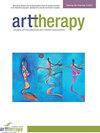A Graphic Guide to Art Therapy
IF 1.3
Q3 PSYCHOLOGY, CLINICAL
引用次数: 0
Abstract
A Graphic Guide to Art Therapy by Amy E. Huxtable in collaboration with Gaelynn P. Wolf Bordonaro and Libby Schmanke delivers exactly what its title promises: a visual and easily digestible primer on the fundamentals of art therapy. Huxtable discusses starting this project in graduate school as her capstone project at Emporia State University. She further states that this book was born out of a desire to use her background in graphic design and to deliver information she wished she had greater access to as a younger person. The fact that this book was approached with love and care is clear in the illustrative style. The use of comics as a tool for education is well executed here, as the book is easy to read from a visual perspective. The book is organized into sections, which include history, frameworks, and models; theories and approaches; and techniques and directives, as well as information and resources on finding art therapists in both the United States and the United Kingdom. Several case study vignettes are also sprinkled throughout the book. Some of the strongest pages both visually and informationally address common misconceptions about art therapy (what art therapy is and is not), as well as the differences and commonalities between art therapy, therapeutic art, and art classes. Huxtable uses the power and minimalism of a Venn diagram to deftly explain what art therapy is and how it is different from other arts-based practices. Other standout aspects of the book include the section on theories and approaches, which impressively covers psychodynamic theories all the way through integrative approaches in less than 100 pages. This book’s value lies in Huxtable’s choice to use comics as her medium. The use of comics in art therapy is not new, and neither is the use of comics as an educational tool. She makes note of that influence in her preface, presenting the intersection of where art therapy meets art education. She states that her original intended audience was art therapy students, but that she also came to realize that finding information about art therapy can be difficult. In acknowledging this, she points to how elusive our field can sometimes be and highlights the need for more accessible literature. The drawing and writing style feels deliberately simplified but not simplistic, which further enhances its approachability without being patronizing to its readers. In this way, the book feels linked to the graphic medicine movement in its desire for broader access to diverse methods of healing. The definition of graphic medicine introduced in The Graphic Medicine Manifesto is “the intersection between the medium of comics and the discourse of healthcare” (Czerwiec et al., 2015, p. 1). Graphic medicine as a movement and concept lends itself well to art therapy because it is also a “movement for change that challenges the dominant methods of scholarship in healthcare, offering a more inclusive perspective of medicine, illness, disability, caregiving, and being cared for” (p. 2). Graphic medicine was born out of narrative medicine, a part of the medical humanities field where practitioners seek to better educate health professionals by challenging the dominant methods of scholarship. This sentiment is echoed in Huxtable’s work in that she uses comics specifically as a tool to provide an inroad to art therapy, a field that is not well understood within the wider field of psychology or by the public at large. One oversight in the choices made by the author regarding content is that the book largely covers history and practice from U.S. and UK perspectives, which feels like a missed opportunity. Although the author uses characters diverse in identity and makes mention of the contributions of people of color specifically, the history presented focuses largely on White Western contributors to the field. Granted, this work is not meant to be an in-depth exploration of art therapy and its global history. Huxtable states specifically that this work is meant to be nonthreatening, and in this sense, she is quite successful. Another element that might not have been the author’s original purpose but, perhaps not surprisingly for a work intended to be a textbook, A Graphic Guide to Art Therapy would likely make an excellent study aide for both the National Counselor Examination (NCE) and Registered Art Therapist with Board Certification (ATR-BC) exam. The visual elements coupled with compact explanations of counseling and art therapy concepts all gathered from disparate sources is incredibly convenient. This book pairs well with literature and scholarship covered in professional development art therapy courses. In conclusion, this book uses humor, as well as practical language and images, to great effect. The book clearly and concisely summarizes, both visually and textually, the history, as well as the techniques and practices that make up the Western approach to art therapy and its intersection with counseling. There is a clear overlap with Huxtable’s desire to create an approachable work with graphic medicine’s values surrounding ease of艺术治疗图解指南
Amy E. Huxtable与Gaelynn P. Wolf Bordonaro和Libby Schmanke合作的《艺术治疗图形指南》正是其标题所承诺的:关于艺术治疗基础的视觉和易于理解的入门。Huxtable讨论了在研究生院开始这个项目作为她在Emporia州立大学的顶点项目。她进一步表示,这本书的诞生是出于一种愿望,即利用她在平面设计方面的背景,并传达她希望自己年轻时能更多地接触到的信息。事实上,这本书是接近与爱和关怀是清楚的说明性的风格。漫画作为教育工具的使用在这里得到了很好的执行,因为这本书从视觉角度来看很容易阅读。本书分为几个部分,包括历史、框架和模型;理论与方法;技术和指令,以及在美国和英国寻找艺术治疗师的信息和资源。几个案例研究的小插曲也散落在书中。一些最强大的页面在视觉上和信息上都解决了关于艺术治疗的常见误解(艺术治疗是什么,不是什么),以及艺术治疗,治疗艺术和艺术课之间的差异和共同点。Huxtable利用维恩图的力量和极简主义巧妙地解释了什么是艺术疗法,以及它与其他基于艺术的实践有何不同。这本书的其他突出方面包括理论和方法部分,令人印象深刻的是,在不到100页的篇幅里,从心理动力学理论一直到综合方法。这本书的价值在于Huxtable选择使用漫画作为她的媒介。在艺术治疗中使用漫画并不新鲜,将漫画用作教育工具也不是什么新鲜事。她在序言中提到了这种影响,展示了艺术治疗与艺术教育的交集。她说,她最初的目标受众是艺术治疗的学生,但她也意识到,寻找有关艺术治疗的信息可能是困难的。在承认这一点时,她指出,我们的领域有时是多么难以捉摸,并强调需要更多的通俗文学。画风和文字风格刻意简化,但不过分简单化,这进一步增强了它的平易近人,而不是居高临下的读者。通过这种方式,这本书感觉与图形医学运动联系在一起,因为它渴望更广泛地获得各种治疗方法。《图形医学宣言》中介绍的图形医学的定义是“漫画媒介与医疗保健话语之间的交集”(Czerwiec等人,2015年,第1页)。图形医学作为一种运动和概念,非常适合艺术治疗,因为它也是一种“变革运动,挑战医疗保健领域的主流学术方法,提供更具包容性的医学、疾病、残疾、护理、医疗保健和医疗保健的视角”。图形医学诞生于叙事医学,这是医学人文领域的一部分,从业者试图通过挑战学术的主导方法来更好地教育卫生专业人员。这种观点在Huxtable的作品中得到了回应,她专门使用漫画作为一种工具,为艺术治疗提供了一种途径,这一领域在更广泛的心理学领域或公众中都没有得到很好的理解。作者在内容选择上的一个疏忽是,这本书主要从美国和英国的角度讲述历史和实践,这让人感觉错过了机会。虽然作者使用了不同身份的人物,并特别提到了有色人种的贡献,但所呈现的历史主要集中在对该领域做出贡献的西方白人。当然,这部作品并不是对艺术疗法及其全球历史的深入探索。Huxtable特别指出,这项工作是不具威胁性的,从这个意义上说,她是相当成功的。另一个可能不是作者最初目的的元素,但对于一本打算成为教科书的作品来说,《艺术治疗图形指南》可能会成为国家咨询师考试(NCE)和注册艺术治疗师委员会认证(ATR-BC)考试的优秀学习助手。视觉元素加上从不同来源收集的咨询和艺术治疗概念的紧凑解释,令人难以置信的方便。这本书很好地与文学和学术涵盖了专业发展艺术治疗课程。总之,这本书运用了幽默,以及实用的语言和形象,取得了很大的效果。 这本书在视觉和文字上都清晰而简洁地总结了历史,以及构成西方艺术治疗方法及其与咨询交叉的技术和实践。这与Huxtable的愿望有明显的重叠,即创造一个平易近人的作品,与图形医学的价值观围绕着易用性
本文章由计算机程序翻译,如有差异,请以英文原文为准。
求助全文
约1分钟内获得全文
求助全文

 求助内容:
求助内容: 应助结果提醒方式:
应助结果提醒方式:


